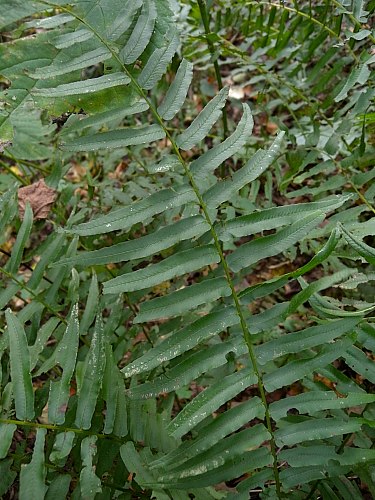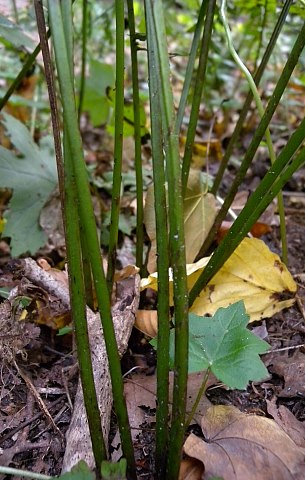Description: This perennial fern develops a cluster of ascending leaves about 1½–3½' tall and it is typically found on moist ground, rather than mossy rocks. Individual leaves are up to 2¾' long and 9" across; they are simple-pinnate with 20-30 pairs of leaflets and elliptic-oblong in outline. The slender petioles are up to 1' long, terete or angular, and glabrous to slightly chaffy. They are purple at the base, becoming green toward the top. The central rachises (stalks) of the leaves are light green and glabrous; they are flattened and grooved along their upper sides.

Individual
leaflets are longest (up to 4½" long) toward the middle of each leaf,
becoming smaller toward the bottom and the top. They are
linear-lanceolate and mostly smooth along their margins; sometimes
their margins are slightly undulate or minutely crenulate (blunt tiny
teeth). The narrow leaflets have truncate to broadly rounded bottoms
and long slender tips. The petiolules of the leaflets are light green
and very short. The upper surfaces of the leaflets are medium green,
glabrous, and slightly shiny, while their lower surfaces are more pale
and glabrous. Each leaflet has a central vein and numerous lateral
veins that are forked or doubly forked; they are more visible on the
lower surface. The leaflets of sterile leaves are slightly wider than
those of fertile leaves. The leaflets of fertile leaves develop dark
elongated sori (spore-bearing structures) with laterally attached
indusia (protective membranes) along both sides of their central veins.
The sori and their indusia form a herringbone pattern on each fertile
leaflet. The tiny spores are released to the wind during late summer or
fall. The root system is fibrous and rhizomatous. Sometimes small
colonies of this fern are produced through vegetative shoots of the
spreading rhizomes. The leaves are deciduous, dying down during the
winter.
Cultivation:
This fern prefers to grow in light shade, moist conditions, and loamy
or silty soil in sheltered areas. It has few problems with disease and
insects. New leaves are produced throughout the summer. This fern is
adaptable to cultivation in gardens.
Range & Habitat:
The native Glade Fern is widely scattered throughout Illinois. In most
areas
of the state, it is uncommon and local, although in the southern tip of
the state it is occasional (see Distribution
Map) Habitats include lower areas of wooded slopes facing
east or north, the bottoms and lower slopes of shaded ravines and rocky
canyons, and moist wooded areas along streams (where flooding does not
occur). This fern is more likely to be found in low rocky areas where
sandstone or limestone is close to the ground surface. It is largely
restricted to high quality natural areas.
Faunal Associations:
Very little is known about the floral-faunal relationships of this
fern. White-Tailed Deer occasionally browse on the leaves. When this
fern forms colonies, it provides significant cover for wildlife.
Photographic Location:
Bottom of a shaded sandstone canyon at Turkey Run State Park in
west-central Indiana.
Comments:
This elegant fern has attractive shiny leaves. It is easy to
distinguish from other ferns by its relatively large size, the
simple-pinnate structure of its leaves, and its long slender leaflets
with smooth margins. Apparently, the closest living relative is a fern
in tropical Malesia (roughly, the area between SE Asia and Australia).
Perhaps, this explains why the Glade Fern has an exotic aura about it.
This fern has an unstable taxonomic history. Older scientific names
include Asplenium pycnocarpon and Athyrium
pycnocarpon, and it is sometimes assigned to the Spleenwort
family (Aspleniaceae). An alternative common name is 'Narrow-Leaved
Spleenwort.'